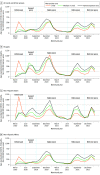COVID-19 Mortality by Race and Ethnicity in US Metropolitan and Nonmetropolitan Areas, March 2020 to February 2022
- PMID: 37129894
- PMCID: PMC10155069
- DOI: 10.1001/jamanetworkopen.2023.11098
COVID-19 Mortality by Race and Ethnicity in US Metropolitan and Nonmetropolitan Areas, March 2020 to February 2022
Abstract
Importance: Prior research has established that Hispanic and non-Hispanic Black residents in the US experienced substantially higher COVID-19 mortality rates in 2020 than non-Hispanic White residents owing to structural racism. In 2021, these disparities decreased.
Objective: To assess to what extent national decreases in racial and ethnic disparities in COVID-19 mortality between the initial pandemic wave and subsequent Omicron wave reflect reductions in mortality vs other factors, such as the pandemic's changing geography.
Design, setting, and participants: This cross-sectional study was conducted using data from the US Centers for Disease Control and Prevention for COVID-19 deaths from March 1, 2020, through February 28, 2022, among adults aged 25 years and older residing in the US. Deaths were examined by race and ethnicity across metropolitan and nonmetropolitan areas, and the national decrease in racial and ethnic disparities between initial and Omicron waves was decomposed. Data were analyzed from June 2021 through March 2023.
Exposures: Metropolitan vs nonmetropolitan areas and race and ethnicity.
Main outcomes and measures: Age-standardized death rates.
Results: There were death certificates for 977 018 US adults aged 25 years and older (mean [SD] age, 73.6 [14.6] years; 435 943 female [44.6%]; 156 948 Hispanic [16.1%], 140 513 non-Hispanic Black [14.4%], and 629 578 non-Hispanic White [64.4%]) that included a mention of COVID-19. The proportion of COVID-19 deaths among adults residing in nonmetropolitan areas increased from 5944 of 110 526 deaths (5.4%) during the initial wave to a peak of 40 360 of 172 515 deaths (23.4%) during the Delta wave; the proportion was 45 183 of 210 554 deaths (21.5%) during the Omicron wave. The national disparity in age-standardized COVID-19 death rates per 100 000 person-years for non-Hispanic Black compared with non-Hispanic White adults decreased from 339 to 45 deaths from the initial to Omicron wave, or by 293 deaths. After standardizing for age and racial and ethnic differences by metropolitan vs nonmetropolitan residence, increases in death rates among non-Hispanic White adults explained 120 deaths/100 000 person-years of the decrease (40.7%); 58 deaths/100 000 person-years in the decrease (19.6%) were explained by shifts in mortality to nonmetropolitan areas, where a disproportionate share of non-Hispanic White adults reside. The remaining 116 deaths/100 000 person-years in the decrease (39.6%) were explained by decreases in death rates in non-Hispanic Black adults.
Conclusions and relevance: This study found that most of the national decrease in racial and ethnic disparities in COVID-19 mortality between the initial and Omicron waves was explained by increased mortality among non-Hispanic White adults and changes in the geographic spread of the pandemic. These findings suggest that despite media reports of a decline in disparities, there is a continued need to prioritize racial health equity in the pandemic response.
Conflict of interest statement
Figures


Update of
-
Geographic and Temporal Patterns in Covid-19 Mortality by Race and Ethnicity in the United States from March 2020 to February 2022.medRxiv [Preprint]. 2022 Jul 21:2022.07.20.22277872. doi: 10.1101/2022.07.20.22277872. medRxiv. 2022. Update in: JAMA Netw Open. 2023 May 1;6(5):e2311098. doi: 10.1001/jamanetworkopen.2023.11098. PMID: 35898347 Free PMC article. Updated. Preprint.
Similar articles
-
Racial and Ethnic Inequities in Cancer Care Continuity During the COVID-19 Pandemic Among Those With SARS-CoV-2.JAMA Netw Open. 2024 May 1;7(5):e2412050. doi: 10.1001/jamanetworkopen.2024.12050. JAMA Netw Open. 2024. PMID: 38767916 Free PMC article.
-
Racial and ethnic disparities in excess mortality among U.S. veterans during the COVID-19 pandemic.Health Serv Res. 2023 Jun;58(3):642-653. doi: 10.1111/1475-6773.14112. Epub 2022 Dec 30. Health Serv Res. 2023. PMID: 36478574 Free PMC article.
-
Associations of Race/Ethnicity and Food Insecurity With COVID-19 Infection Rates Across US Counties.JAMA Netw Open. 2021 Jun 1;4(6):e2112852. doi: 10.1001/jamanetworkopen.2021.12852. JAMA Netw Open. 2021. PMID: 34100936 Free PMC article.
-
Retrospective analysis of ethnic/racial disparities and excess vascular mortality associated with the COVID-19 pandemic.Curr Probl Cardiol. 2024 Oct;49(10):102763. doi: 10.1016/j.cpcardiol.2024.102763. Epub 2024 Jul 24. Curr Probl Cardiol. 2024. PMID: 39059784 Review.
-
Racial and Ethnic Disparities in COVID-19-Related Infections, Hospitalizations, and Deaths : A Systematic Review.Ann Intern Med. 2021 Mar;174(3):362-373. doi: 10.7326/M20-6306. Epub 2020 Dec 1. Ann Intern Med. 2021. PMID: 33253040 Free PMC article.
Cited by
-
COVID-19 Pandemic and Racial and Ethnic Disparities in Long-Term Nursing Home Stay or Death Following Hospital Discharge.JAMA Netw Open. 2025 Jan 2;8(1):e2456816. doi: 10.1001/jamanetworkopen.2024.56816. JAMA Netw Open. 2025. PMID: 39853973 Free PMC article.
-
Factors Influencing COVID-19 Vaccine Uptake among Spanish-Speaking Pregnant People.Vaccines (Basel). 2023 Nov 17;11(11):1726. doi: 10.3390/vaccines11111726. Vaccines (Basel). 2023. PMID: 38006058 Free PMC article.
-
Nirmatrelvir/ritonavir and risk of long COVID symptoms: a retrospective cohort study.Sci Rep. 2023 Nov 11;13(1):19688. doi: 10.1038/s41598-023-46912-4. Sci Rep. 2023. PMID: 37951998 Free PMC article.
-
Cardiovascular effects of the post-COVID-19 condition.Nat Cardiovasc Res. 2024 Feb;3(2):118-129. doi: 10.1038/s44161-023-00414-8. Epub 2024 Jan 18. Nat Cardiovasc Res. 2024. PMID: 39196189 Review.
-
Greater stress and trauma mediate race-related differences in epigenetic age between Black and White young adults in a community sample.Neurobiol Stress. 2023 Jul 21;26:100557. doi: 10.1016/j.ynstr.2023.100557. eCollection 2023 Sep. Neurobiol Stress. 2023. PMID: 37501940 Free PMC article.
References
-
- Chen JT, Krieger N. Revealing the Unequal Burden of COVID-19 by Income, Race/Ethnicity, and Household Crowding: US County Versus Zip Code Analyses. J Public Health Manag Pract. 2021;27(Suppl 1, COVID-19 and Public Health: Looking Back, Moving Forward):S43-S56. doi:10.1097/PHH.0000000000001263 - DOI - PubMed
Publication types
MeSH terms
Grants and funding
LinkOut - more resources
Full Text Sources
Medical

